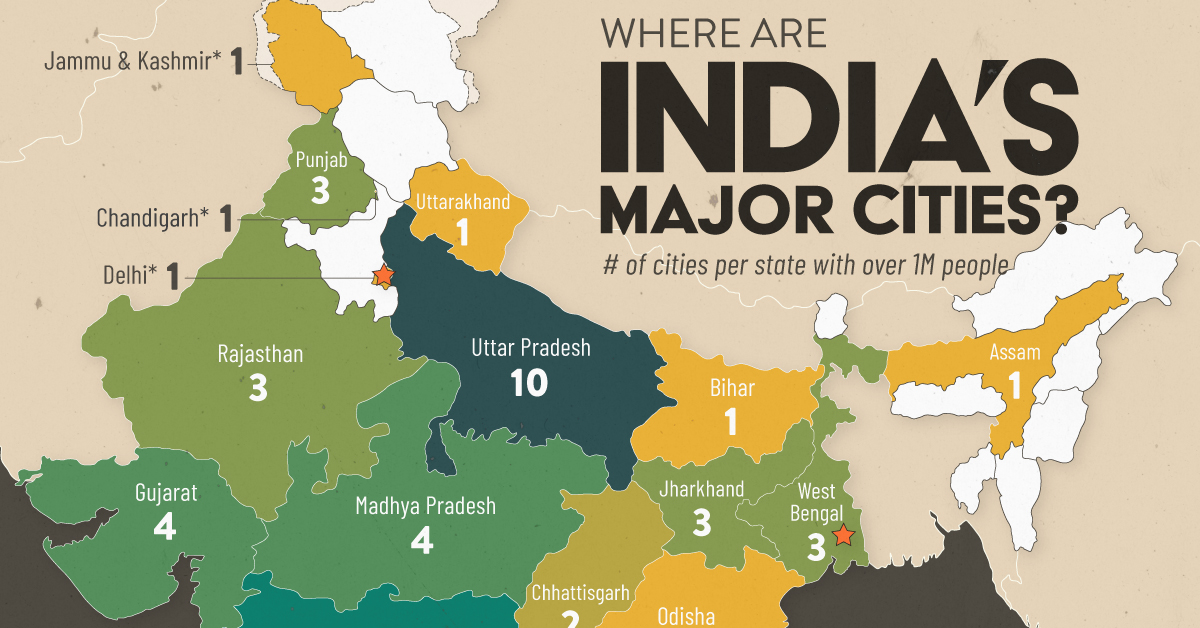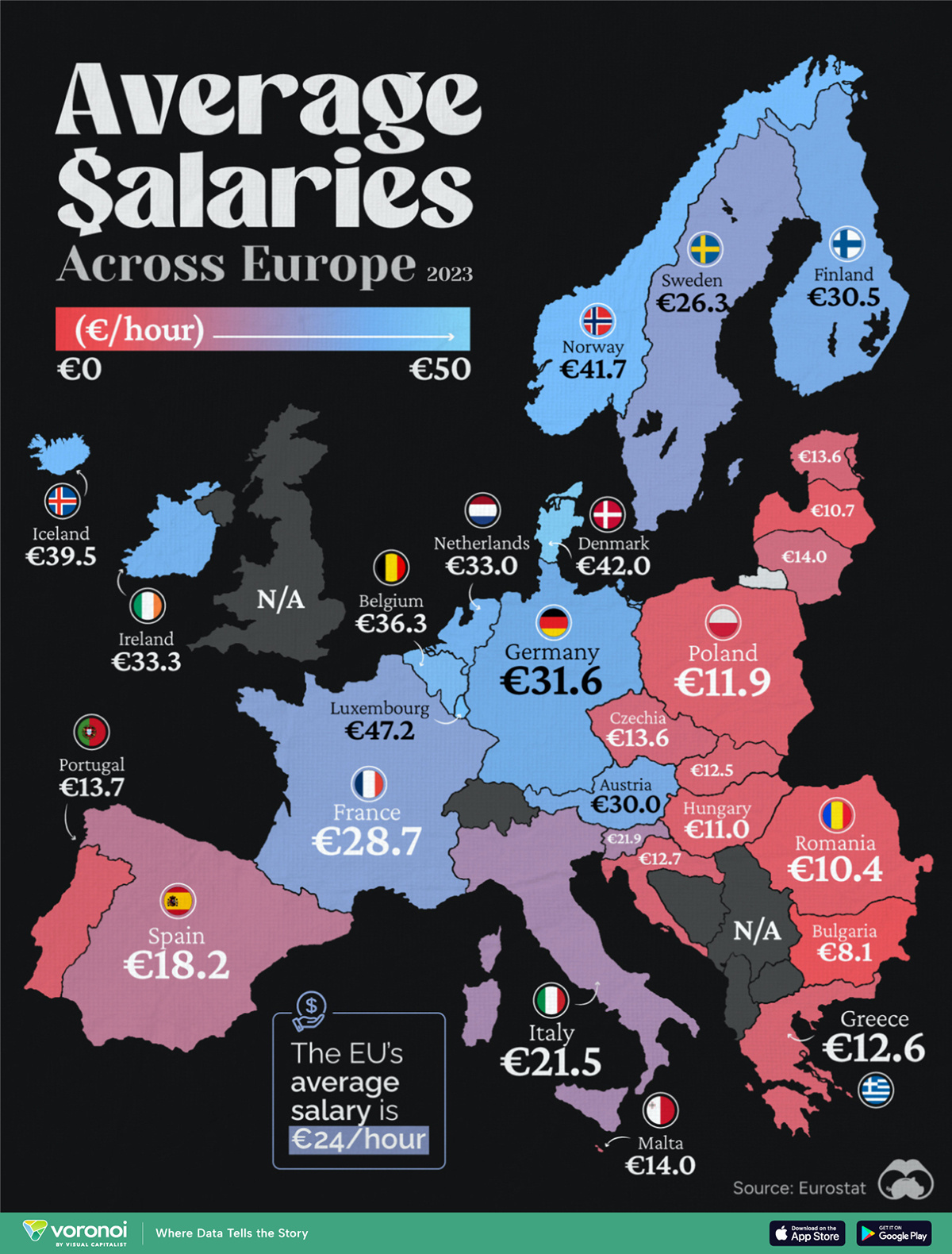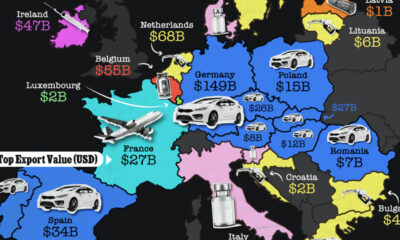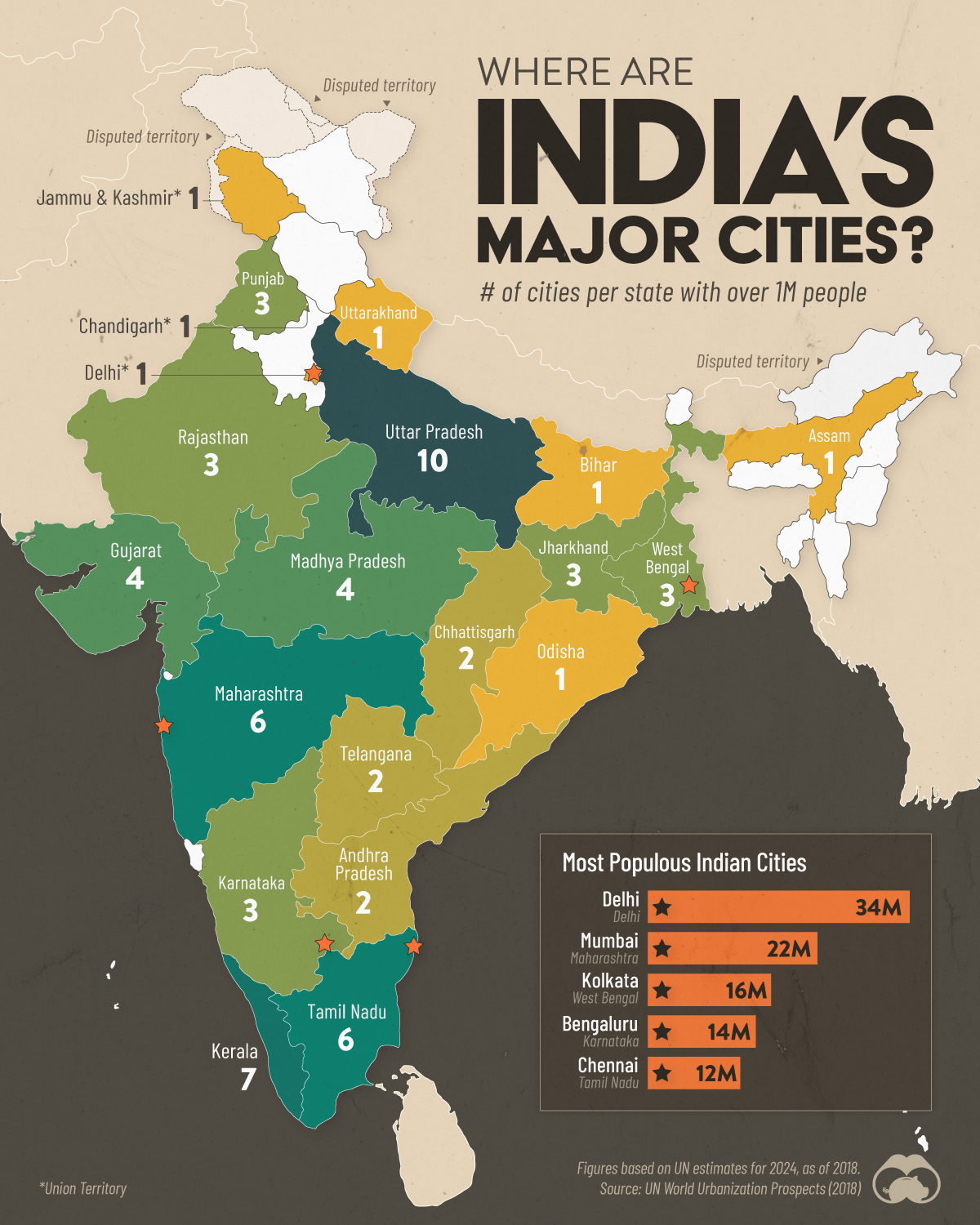Maps
Mapped: Average Wages Across Europe
![]() See this visualization first on the Voronoi app.
See this visualization first on the Voronoi app.
Mapped: Average Wages Across Europe
This was originally posted on our Voronoi app. Download the app for free on Apple or Android and discover incredible data-driven charts from a variety of trusted sources.
Much and more has been written about the best countries in Europe to visit, sight-see at, or vacation in.
But the economic powerhouse of a continent also has eight of the top 20 largest economies, the biggest single-market area, and some of the richest countries in the world.
How does all of that translate into how much people earn across the continent?
We visualize the average hourly salary (in euros), across Europe in a heatmap. The bluer the hue, the higher the hourly salary. Data for this visualization comes from Eurostat and is current up to 2023.
Ranked: European Countries By Average Hourly Salaries
Luxembourg, Europe’s financial services capital, has the highest average salary (€47/hour) across the continent. The country also has the highest per capita GDP in the world.
Scandinavia’s Denmark and Norway also pay higher (€42/hour) though Sweden (€26/hour) falls more in the middle of the pack.
| Rank | Country | Average Salary (€/hour) |
|---|---|---|
| 1 | 🇱🇺 Luxembourg | €47.2 |
| 2 | 🇩🇰 Denmark | €42.0 |
| 3 | 🇳🇴 Norway | €41.7 |
| 4 | 🇮🇸 Iceland | €39.5 |
| 5 | 🇧🇪 Belgium | €36.3 |
| 6 | 🇮🇪 Ireland | €33.3 |
| 7 | 🇳🇱 Netherlands | €33.0 |
| 8 | 🇩🇪 Germany | €31.6 |
| 9 | 🇫🇮 Finland | €30.5 |
| 10 | 🇦🇹 Austria | €30.0 |
| 11 | 🇫🇷 France | €28.7 |
| 12 | 🇸🇪 Sweden | €26.3 |
| 13 | 🇸🇮 Slovenia | €21.9 |
| 14 | 🇮🇹 Italy | €21.5 |
| 15 | 🇪🇸 Spain | €18.2 |
| 16 | 🇨🇾 Cyprus | €16.3 |
| 17 | 🇱🇹 Lithuania | €14.0 |
| 18 | 🇲🇹 Malta | €14.0 |
| 19 | 🇵🇹 Portugal | €13.7 |
| 20 | 🇨🇿 Czechia | €13.6 |
| 21 | 🇪🇪 Estonia | €13.6 |
| 22 | 🇭🇷 Croatia | €12.7 |
| 23 | 🇬🇷 Greece | €12.6 |
| 24 | 🇸🇰 Slovakia | €12.5 |
| 25 | 🇵🇱 Poland | €11.9 |
| 26 | 🇭🇺 Hungary | €11.0 |
| 27 | 🇱🇻 Latvia | €10.7 |
| 28 | 🇷🇴 Romania | €10.4 |
| 29 | 🇧🇬 Bulgaria | €8.1 |
| N/A | 🇪🇺 EU | €24.0 |
Note: The source has not provided data for Russia, the UK, Switzerland, Serbia, Bosnia & Herzegovina, Liechtenstein, Andorra, San Marino, Monaco, and Vatican City.
Bulgaria records the lowest average salary in this dataset at €8/hour.
The map indicates Northern and Western Europe have higher average wages than Southern and Eastern Europe, reflecting the differences in economic development and wealth.
However, this split has not always been present. In fact, the reverse was true for many centuries. Mediterranean-based civilizations used to be some of the wealthiest in the world, benefiting greatly from the sea’s access across to Northern Africa and the Levant.
But by the 16th and 17th centuries, Atlantic Ocean trade opened up access to far bigger markets, driving up economic growth and wealth accumulation for the western half of Europe.
Naturally, the map of average salaries is also a reflection of the cost of living as well, influencing purchasing power, lifestyle choices, and overall economic conditions for individuals and families.
Economy
Mapped: Indian States with Cities Over 1 Million People
Ten Indian states—most of them from the northeast region of the country—don’t have a single city with 1 million residents.

Mapped: Indian States with Cities Over 1 Million People
This was originally posted on our Voronoi app. Download the app for free on iOS or Android and discover incredible data-driven charts from a variety of trusted sources.
Slightly more than one-third of the 1.4 billion Indian population lives in an urban area. So where are the country’s most populous cities, and how are they spread across the country’s 28 states and eight union territories?
This map shows the number of Indian urban agglomerations (cities) with more than a million residents in each jurisdiction. Data for this graphic is sourced from 2024 urban agglomeration estimates in the UN World Urbanization Prospects.
Ranked: Indian States by Cities with 1M Residents
India’s Uttar Pradesh state has 10 cities with a population size of 1 million or more. It is also India’s most populous state, home to 240 million people. This makes it comparable to the size of Pakistan, the fifth most populous country in the world.
| Indian State | Cities with 1M Residents (2024) | City Names |
|---|---|---|
| Uttar Pradesh | 10 | Lucknow, Kanpur, Agra, Meerut, Varanasi, Prayagraj, Bareilly, Aligarh, Moradabad, Saharanpur |
| Kerala | 7 | Kozhikode, Malappuram, Thrissur, Kochi, Thiruvananthapura, Kannur, Kollam |
| Maharashtra | 6 | Mumbai, Pune, Nagpur, Nashik, Aurangabad, Solapur |
| Tamil Nadu | 6 | Chennai, Coimbatore, Madurai, Tiruppur, Tiruchirappalli, Salem |
| Gujarat | 4 | Ahmedabad, Surat, Vadodara, Rajkot |
| Madhya Pradesh | 4 | Indore, Bhopal, Jabalpur, Gwalior |
| Jharkhand | 3 | Jamshedpur, Ranchi, Dhanbad |
| Karnataka | 3 | Bengaluru, Mysore, Hubli-Dharwad |
| Punjab | 3 | Ludhiana, Amritsar, Jalandhar |
| Rajasthan | 3 | Jaipur, Jodhpur, Kota |
| West Bengal | 3 | Kolkata, Asansol, Siliguri |
| Andhra Pradesh | 2 | Visakhapatnam, Vijayawada |
| Chhattisgarh | 2 | Raipur, Durg-Bhilainagar |
| Telangana | 2 | Hyderabad, Warangal |
| Assam | 1 | Guwahati |
| Bihar | 1 | Patna |
| Odisha | 1 | Bhubaneswar |
| Uttarakhand | 1 | Dehradun |
| Chandigarh* | 1 | Chandigargh |
| Delhi* | 1 | New Delhi |
| Jammu & Kashmir* | 1 | Srinagar |
*Union Territories. Figures rounded. Some city names may have changed since this data was published.
Further south, Kerala (7), Maharashtra (6), and Tamil Nadu (6) also have more than five cities with a million or more people.
Meanwhile, some cities, including India’s national capital, New Delhi, are either in or are themselves union territories—areas directly administered by the central government.
Ten Indian states—most of them from the country’s northeast region—don’t have a single city with 1 million residents.
All together, India has 65 cities with more than one million inhabitants. For comparison, China has 105, and the U.S. has nine.
| Rank | City | State/Union Territory | 2024 Population Estimates |
|---|---|---|---|
| 1 | New Delhi | Delhi* | 34M |
| 2 | Mumbai | Maharashtra | 22M |
| 3 | Kolkata | West Bengal | 16M |
| 4 | Bengaluru | Karnataka | 14M |
| 5 | Chennai | Tamil Nadu | 12M |
| 6 | Hyderabad | Telangana | 11M |
| 7 | Ahmadabad | Gujarat | 9M |
| 8 | Surat | Gujarat | 8M |
| 9 | Pune | Maharashtra | 7M |
| 10 | Jaipur | Rajasthan | 4M |
| 11 | Kozhikode | Kerala | 4M |
| 12 | Malappuram | Kerala | 4M |
| 13 | Lucknow | Uttar Pradesh | 4M |
| 14 | Thrissur | Kerala | 4M |
| 15 | Kochi | Kerala | 4M |
| 16 | Indore | Madhya Pradesh | 3M |
| 17 | Kanpur | Uttar Pradesh | 3M |
| 18 | Nagpur | Maharashtra | 3M |
| 19 | Coimbatore | Tamil Nadu | 3M |
| 20 | Thiruvananthapuram | Kerala | 3M |
| 21 | Patna | Bihar | 3M |
| 22 | Bhopal | Madhya Pradesh | 3M |
| 23 | Agra | Uttar Pradesh | 3M |
| 24 | Kannur | Kerala | 2M |
| 25 | Visakhapatnam | Andhra Pradesh | 2M |
| 26 | Vadodara | Gujarat | 2M |
| 27 | Nashik | Maharashtra | 2M |
| 28 | Vijayawada | Andhra Pradesh | 2M |
| 29 | Kollam | Kerala | 2M |
| 30 | Rajkot | Gujarat | 2M |
| 31 | Ludhiana | Punjab | 2M |
| 32 | Madurai | Tamil Nadu | 2M |
| 33 | Raipur | Chhattisgarh | 2M |
| 34 | Meerut | Uttar Pradesh | 2M |
| 35 | Varanasi | Uttar Pradesh | 2M |
| 36 | Srinagar | Jammu & Kashmir* | 2M |
| 37 | Tiruppur | Tamil Nadu | 2M |
| 38 | Jamshedpur | Jharkhand | 2M |
| 39 | Aurangabad | Maharashtra | 2M |
| 40 | Jodhpur | Rajasthan | 2M |
| 41 | Ranchi | Jharkhand | 2M |
| 42 | Kota | Rajasthan | 2M |
| 43 | Jabalpur | Madhya Pradesh | 2M |
| 44 | Asansol | West Bengal | 2M |
| 45 | Gwalior | Madhya Pradesh | 2M |
| 46 | Allahabad | Uttar Pradesh | 2M |
| 47 | Amritsar | Punjab | 1M |
| 48 | Dhanbad | Jharkhand | 1M |
| 49 | Bareilly | Uttar Pradesh | 1M |
| 50 | Aligarh | Uttar Pradesh | 1M |
| 51 | Moradabad | Uttar Pradesh | 1M |
| 52 | Mysore | Karnataka | 1M |
| 53 | Durg-Bhilainagar | Chhattisgarh | 1M |
| 54 | Bhubaneswar | Odisha | 1M |
| 55 | Tiruchirappalli | Tamil Nadu | 1M |
| 56 | Chandigarh | Chandigarh* | 1M |
| 57 | Saharanpur | Uttar Pradesh | 1M |
| 58 | Hubli-Dharwad | Karnataka | 1M |
| 59 | Guwahati | Assam | 1M |
| 60 | Salem | Tamil Nadu | 1M |
| 61 | Siliguri | West Bengal | 1M |
| 62 | Jalandhar | Punjab | 1M |
| 63 | Solapur | Maharashtra | 1M |
| 64 | Warangal | Telangana | 1M |
| 65 | Dehradun | Uttarakhand | 1M |
*Union Territories. Figures rounded. Some city names may have changed since this data was published.
Interestingly, three of the five most populous Indian cities (Mumbai, Kolkata, and Chennai) were villages that became key British trading outposts. As a result all three cities have a fort within their city limits which acted as protection against competing colonial interests at the time.
Finally, Uttar Pradesh—which leads the states by number of cities with 1M people—doesn’t have a single metropolis within the top 10.
-

 Healthcare2 weeks ago
Healthcare2 weeks agoWhich Countries Have the Highest Infant Mortality Rates?
-

 Misc1 week ago
Misc1 week agoVisualizing Global Losses from Financial Scams
-

 population1 week ago
population1 week agoMapped: U.S. States By Number of Cities Over 250,000 Residents
-

 Business1 week ago
Business1 week agoCharted: How the Logos of Select Fashion Brands Have Evolved
-

 United States1 week ago
United States1 week agoMapped: Countries Where Recreational Cannabis is Legal
-

 Misc1 week ago
Misc1 week agoVisualized: Aircraft Carriers by Country
-

 Culture1 week ago
Culture1 week agoHow Popular Snack Brand Logos Have Changed
-

 Mining2 weeks ago
Mining2 weeks agoVisualizing Copper Production by Country in 2023













